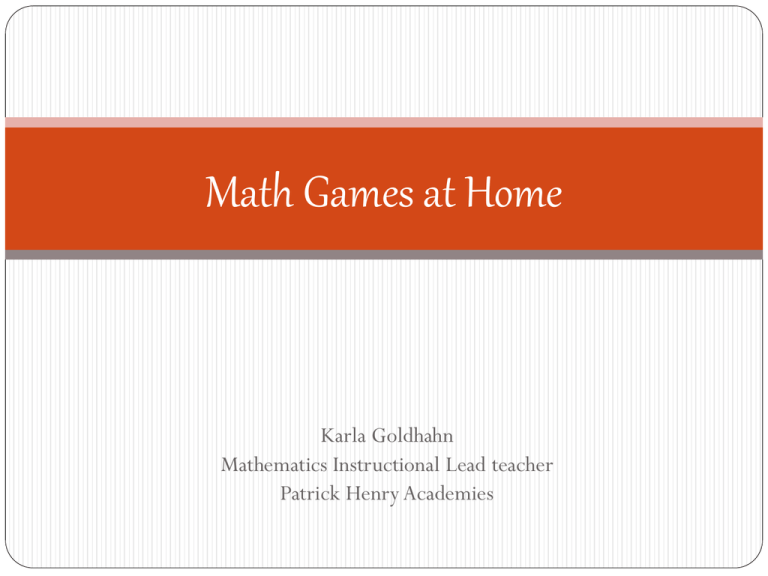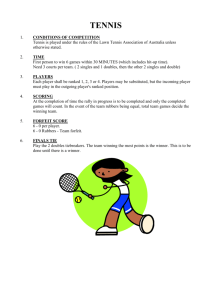Math Games at Home - Henry County Schools
advertisement

Math Games at Home Karla Goldhahn Mathematics Instructional Lead teacher Patrick Henry Academies “Families have a major influence on their children’s achievement in school and through life. When schools, families and community groups work together to support learning, children tend to do better in school, stay in school longer and like school more.” ~The Impact of School and Family Why games are great… Check out this article on the benefits of playing games: http://www.scholastic.com/resources/article/the-benefitsof-board-games Games are fun. Children learn number sense, how to follow directions, how to be a good winner or loser, and strategies. Games encourage families to spend quality time together. The following slides are examples of home-made games that you can recreate at home. Traditional games that encourage math skills: Yahtzee Dominoes Life Monopoly Quelf Card games: Go Fish, War, Rummy For more ideas, or to check-out games and resources from the school, visit the Parent Resource Center at Patrick Henry (North Campus). Open during school hours Game: Doubles Memory Purpose: The purpose of this activity is to help your child to learn the pairs of numbers that add to 10. What you need: Playing cards: Aces= 1 2-10= their numerical value J-K (all face cards)= 10 What to do: This is game is played like Memory. The cards are first spread out, ideally the cards are spread in an array. The first person turns over two cards, keeping them in their original location, if they add to 10 the player takes the pair and has another turn. If the cards do not match, they replace the cards them to the same place face down. The next player has a turn. The winner is the player with the most pairs. What to expect your child to do: To quickly recognize a pair of cards that equals a sum of 10. Dice Games Game: Multiply on the Fly • One person rolls three number cubes • All players write the multiplication equation on a board or in math journals. For example: 3x2x5=30 • The first person with an accurate equation receives 10 points • All other players with an accurate equation receive 5 points • Play continues until someone reaches 100 total points. Game: Multiply on the Fly Questions parents can ask: What was the multiplication strategy that you used? If you change the order of the factors will you still get the same product? What is the highest/lowest product possible each time the 3 number cubes are rolled? Variations to make it easier or harder: Add instead of multiply Use more or less dice Challenge: Try this activity using 5 number cubes. Game: How Low Can You Go? Which decimal fraction is smaller? How do you know? • Each player uses her/his own place value frame. . • Roll a number cube and write the number that comes up in one of your five sections. The other player also writes the same number in one of her/his five sections (not necessarily the same section because each player may use a different strategy to choose which section). • Continue taking turns rolling the number cube and writing the decimal digits until all of the sections are filled. • Compare the numbers created. The player with the smallest number wins the round. Remember to accurately read the number (the word “and” is only used at the decimal point). • Play 3 rounds. Game: How Low Can You Go? Questions parents can ask: Which decimal place is that? How do you know? Why did you place the digit there? What was your strategy? Challenge: Try playing to get the largest number. Shapes Shape Dance Have your child dance in shapes. Together make up a dance routine where you and your child dance in squares, circles, triangles, and rectangles. Set your routine to music and perform it in front of other family members. Have family members guess what shape is being made http://www.brainpopjr.com/math/geometry/planeshapes/grownups.weml Strategy Game: Last Survivor Here are the rules. 1. This game is for 2 players. The object is to be the player who takes the Last tile. 2. Players lay out 13 tiles. 3. Players take turns removing 1,2 or 3 tiles at a time. No player may skip a turn. 4. The player who takes the last tile is the Last Survivor and wins the game. • Play several games of Last Survivor. • Be ready to talk about good moves and bad moves. Game: Doubles & Halves Purpose: The purpose of this activity is to help your child to learn doubles of numbers and their corresponding halves. For example 10 + 10 = 20, and of 20 is 10, 8 + 8 = 16 and of 16 is 8. What you need: Game cards.You can print these or make your own. (next slide) What to do: Use the doubles and halves cards to play memory. The aim of the game is to find as many matching pairs as possible by remembering where the cards are. Spread out all the cards face down. Turn over 2 cards. If the cards match, for example “ of 4” and “2” players get to keep the pair. If the cards don’t match, players replace them face down. Take turns to try and find a matching pair. The winner is the player with the most pairs at the end of the game. Have many pairs can you get? What to expect your child to do: Be able to instantly recall doubles and their corresponding halves. Game Cards: Doubles & Halves 1 ½ of 2 2 ½ of 4 3 ½ of 6 4 ½ of 8 5 ½ of 10 6 ½ of 12 7 ½ of 14 8 ½ of 16 9 ½ of 18 10 ½ of 20 What Process Standards do games encourage? • Students will solve problems (using appropriate • • • • technology). Students will reason and evaluate mathematical arguments. Students will communicate mathematically. Students will make connections among mathematical ideas and to other disciplines. Students will represent mathematics in multiple ways.








